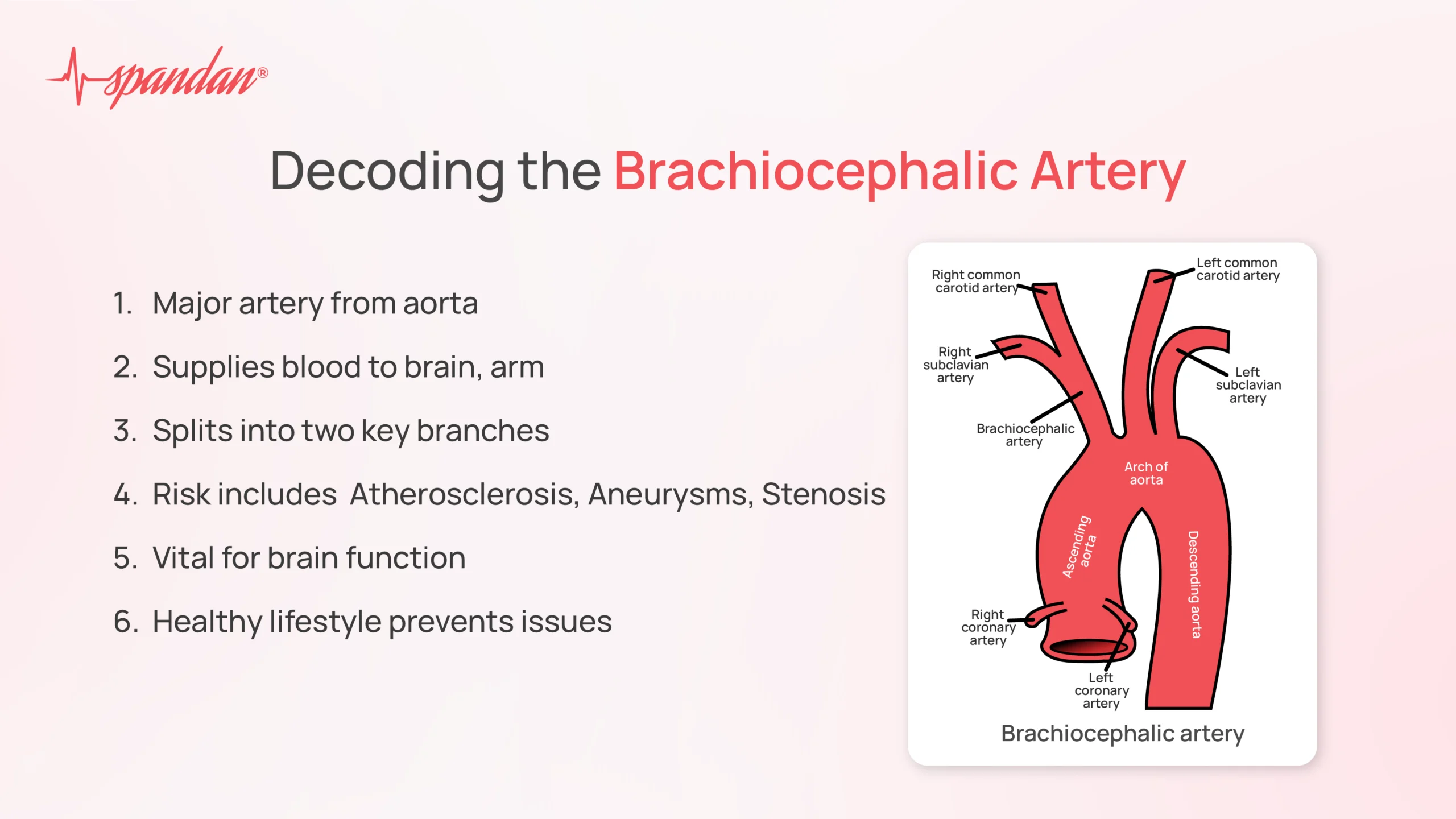
Related Article
Author:- Mr. Ritesh Sharma
The human circulatory system is an intricate network that ensures the efficient delivery of oxygen and nutrients throughout the body. Among the many arteries that form this system, the brachiocephalic artery stands out as one of the most critical. Understanding its anatomy, function, and relevance in health and disease is essential for anyone interested in human biology or medicine.
What is the Brachiocephalic Artery?
The brachiocephalic artery, also known as the innominate artery, is a major blood vessel that branches off from the aortic arch. It is the first and largest branch of the aorta, the main artery that carries oxygenated blood from the heart to the rest of the body. The brachiocephalic artery plays a crucial role in supplying blood to the upper right side of the body, including the head, neck, and right arm.
Anatomical Structure and Branches
The brachiocephalic artery originates from the aortic arch, located just above the heart. It extends upward and to the right, approximately 4 to 5 centimeters in length, before dividing into two significant branches: the right subclavian artery and the right common carotid artery.
- Right Subclavian Artery: This branch supplies blood to the right arm, as well as parts of the chest and shoulder. It continues as the axillary artery and eventually becomes the brachial artery, which further divides into arteries that supply the forearm and hand.
- Right Common Carotid Artery: This artery travels upward along the neck and supplies blood to the right side of the head and neck, including the brain. It eventually divides into the internal and external carotid arteries, which serve different regions of the head.
Together, these branches ensure that the brain, neck, and right upper limb receive a steady and sufficient supply of oxygenated blood.
Function and Importance
The brachiocephalic artery’s primary function is to facilitate the distribution of blood to critical areas of the upper body. The importance of this artery cannot be overstated, as it ensures that the brain and right arm receive the oxygen and nutrients necessary for their functions.
The brain, being one of the most metabolically active organs in the body, requires a constant and abundant blood supply. The right common carotid artery, a direct branch of the brachiocephalic artery, is responsible for delivering blood to the brain. Any disruption in blood flow through the brachiocephalic artery can have severe consequences, including stroke or transient ischemic attacks (TIAs), which are often referred to as mini-strokes.
Clinical Significance
The brachiocephalic artery, like other arteries, can be affected by various conditions, most notably atherosclerosis, aneurysms, and stenosis.
- Atherosclerosis: This condition involves the buildup of fatty deposits (plaque) inside the arteries, leading to narrowing and reduced blood flow. Atherosclerosis in the brachiocephalic artery can result in compromised blood flow to the brain and right arm, increasing the risk of stroke and other cardiovascular events.
- Aneurysms: An aneurysm is a weakened area in the artery wall that can balloon out and potentially rupture. A brachiocephalic artery aneurysm is a rare but serious condition that can lead to life-threatening internal bleeding if not treated promptly.
- Stenosis: Stenosis refers to the narrowing of the artery, often due to atherosclerosis. Brachiocephalic artery stenosis can lead to reduced blood flow and increased risk of stroke or ischemic events. Symptoms may include dizziness, fainting, or even loss of consciousness, particularly during physical activity.
- Subclavian Steal Syndrome: This rare condition occurs when there is a significant blockage in the subclavian artery, causing blood to be “stolen” from the brain to supply the arm. Although the problem originates in the subclavian artery, the brachiocephalic artery’s involvement can exacerbate the issue.
Diagnosis and Treatment
Diagnosing conditions related to the brachiocephalic artery typically involves imaging studies such as ultrasound, computed tomography (CT) scans, or magnetic resonance imaging (MRI). These tests allow healthcare providers to visualize the artery and assess any blockages, narrowing, or aneurysms.
Treatment depends on the specific condition and its severity. In cases of mild atherosclerosis or stenosis, lifestyle changes, medication, and monitoring may be sufficient. These lifestyle changes may include a heart healthier diet, increased physical activity, and quitting smoking to reduce the progression of atherosclerosis.
For more severe conditions, such as significant stenosis or aneurysms, surgical intervention may be necessary. Endovascular procedures, such as angioplasty and stenting, can be used to open up narrowed sections of the artery. In cases of aneurysms, surgery may involve reinforcing the artery wall or removing the aneurysm entirely.
Preventive Measures
Preventing issues related to the brachiocephalic artery involves adopting a heart-healthy lifestyle. This includes:
- Regular Exercise: Engaging in physical activity helps maintain cardiovascular health and reduces the risk of atherosclerosis.
- Healthy Diet: A diet rich in fruits,
- vegetables, whole grains, and lean proteins while low in saturated fats and cholesterol can help prevent plaque buildup in the arteries.
- Smoking Cessation: Smoking is a significant risk factor for atherosclerosis and other cardiovascular diseases. Quitting smoking can dramatically reduce the risk of developing conditions that affect the brachiocephalic artery.
- Regular Check-ups: Monitoring blood pressure, cholesterol levels, and overall cardiovascular health can help detect and address potential issues before they become severe.
The brachiocephalic artery is a vital component of the human circulatory system, ensuring that the brain, neck, and right arm receive adequate blood supply. Its role in maintaining proper blood flow to these critical areas underscores its importance in overall cardiovascular health. Understanding the anatomy, function, and potential issues related to the brachiocephalic artery can aid in early detection and treatment of related conditions, ultimately improving health outcomes.
Whether you are a medical professional, a student, or simply someone interested in human biology, knowing about the brachiocephalic artery and its significance is essential. By maintaining a healthy lifestyle and being aware of the risks, we can better protect this crucial artery and, by extension, our overall health.




